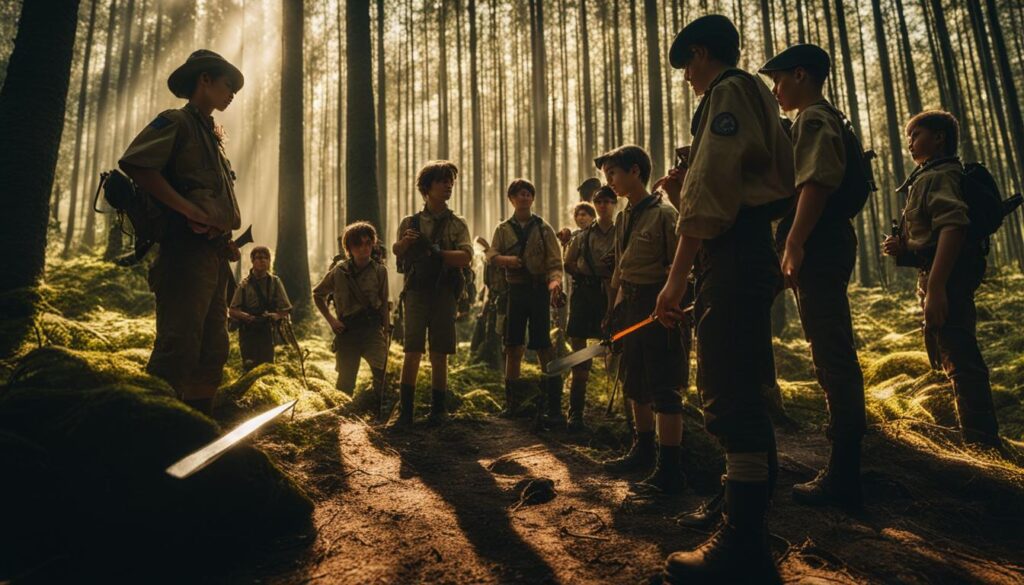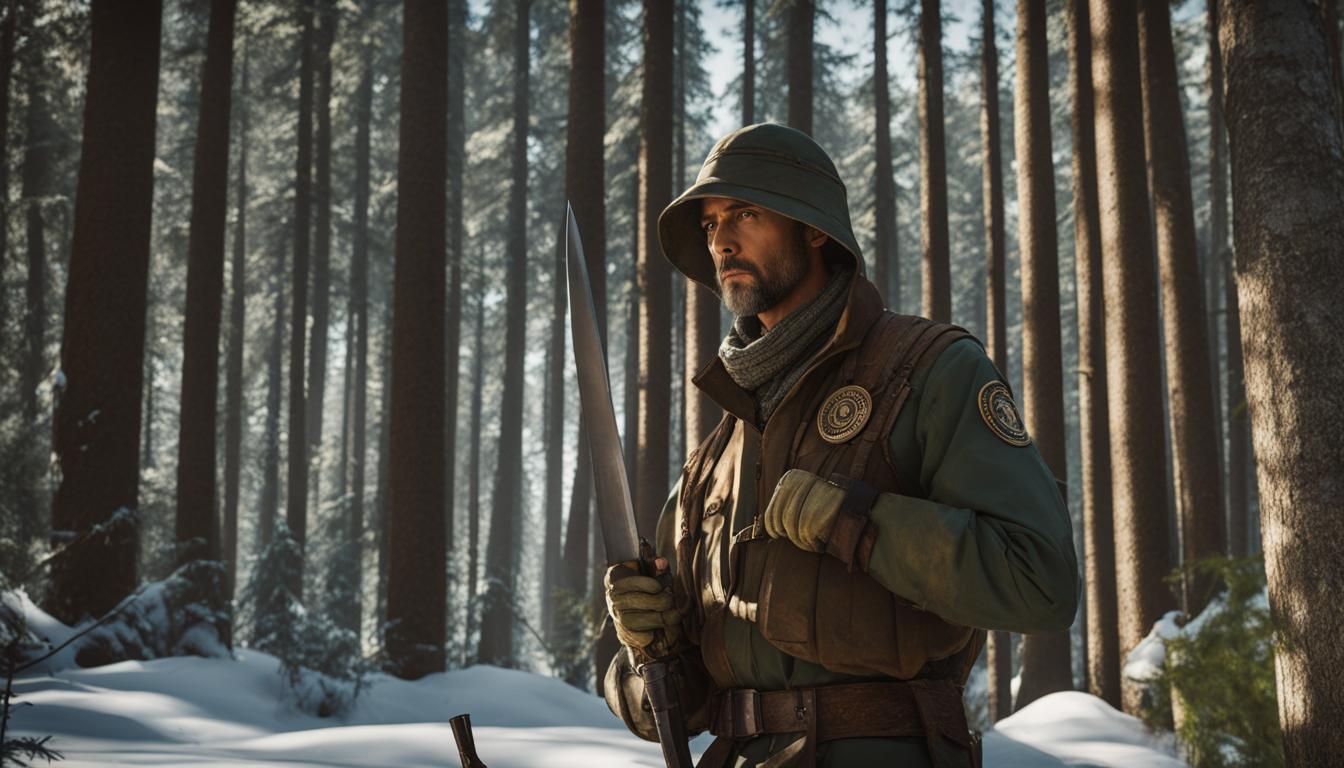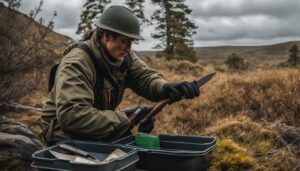As an experienced hunter, I know that safety should always be a top priority when it comes to using hunting knives. That’s why I want to emphasize the importance of knife safety certification programs.
Knife safety certification programs provide essential training and education on proper knife safety techniques. These programs are designed to ensure that hunters have the necessary skills to handle knives safely and responsibly, ultimately preventing accidents and injuries.
With the increasing popularity of hunting and outdoor activities, the need for knife safety certification has become more important than ever. By participating in these programs, hunters can stay sharp and stay safe, enhancing their hunting experience while minimizing the risk of accidents.
Key Takeaways:
- Knife safety certification programs are crucial for safe and responsible knife usage in hunting.
- These programs provide training and education on proper knife safety techniques.
- Participating in certification programs helps prevent accidents and injuries.
- Knife safety certification is particularly important in the growing outdoor activities sector.
- By obtaining certification, hunters can enhance their skills and reduce the risk of accidents.
The Dangers of Knife Mishaps in the Backcountry
Accidents involving hunting knives can occur anywhere, but they can be particularly dangerous when they happen in the backcountry, far away from medical facilities. These mishaps can range from minor cuts to more severe injuries, and they often occur due to a lack of proper knife safety precautions. An unfortunate scenario that highlights the dangers of knife mishaps is two hunters in the Wyoming backcountry accidentally injuring themselves while processing a bull they had just taken down. This incident emphasizes the importance of being prepared and following proper knife safety protocol to prevent such accidents.
In the wilderness, the risk of backcountry knife accidents is amplified by the remote location and limited access to medical help. With no immediate medical assistance available, even a minor cut can quickly escalate into a serious situation. This makes it crucial for hunters to be fully aware of proper knife safety techniques and protocols before embarking on their outdoor adventures. By equipping themselves with this knowledge, hunters can significantly reduce the risk of knife mishaps and ensure a safe and enjoyable experience in the backcountry.
To fully comprehend the severity of knife injuries in the wilderness, let’s examine the data:
| Year | Total Backcountry Knife Accidents | Severe Injuries | Minor Injuries |
|---|---|---|---|
| 2017 | 78 | 22 | 56 |
| 2018 | 92 | 28 | 64 |
| 2019 | 103 | 34 | 69 |
As shown in the data, the number of backcountry knife accidents has been increasing over the years, resulting in severe and minor injuries. These incidents serve as a stark reminder of the importance of knife safety in wilderness settings. By consistently practicing proper knife handling techniques and following safety precautions, hunters can significantly reduce the likelihood of becoming a statistic in the growing number of backcountry knife mishaps.
Common Sense Tips for Knife Safety
Proper knife handling is essential for ensuring safety during outdoor activities. By following these common sense tips, you can minimize the risk of accidents and injuries caused by knives.
1. Use a sharp knife:
A sharp knife requires less pressure to cut, reducing the chances of losing control and accidentally injuring yourself. Regularly sharpen your knives to maintain their sharpness.
2. Cut away from the body:
Always position the knife blade away from your body when cutting. This prevents accidental slips or cuts towards yourself, keeping you safe while using the knife.
3. Pay full attention:
When handling a knife, give it your full focus and concentration. Avoid distractions and ensure you are fully aware of the blade’s position to prevent accidental slips or injuries.
4. Work methodically and slowly:
Rushing while using a knife can lead to careless mistakes. Take your time and work at a steady pace, keeping your movements precise and controlled.
5. Use caution and good communication when working with others:
If you are working with others, ensure clear communication is maintained to prevent accidents. Be mindful of each other’s movements and coordinate tasks to prevent any mishaps.
6. Choose the right knife for each task:
Using the appropriate knife for a specific task is important. Make sure you have the right tool for the job to minimize the risk of accidents or damage caused by using the wrong knife.
7. Take breaks to prevent muscle fatigue:
Repeatedly using a knife can cause muscle fatigue, affecting your grip and control. Take regular breaks to rest and prevent tiredness, which can lead to accidents.
8. Avoid using knives for prying or screwdriving:
Knives are not designed for prying or screwdriving tasks. Using a knife for such purposes can damage the blade or cause it to snap, resulting in potential injuries. Use the appropriate tools for these tasks.
By following these common sense tips, you can ensure a safer knife-handling experience and minimize the risk of accidents and injuries.
| Common Sense Tips for Knife Safety |
|---|
| Use a sharp knife |
| Cut away from the body |
| Pay full attention |
| Work methodically and slowly |
| Use caution and good communication when working with others |
| Choose the right knife for each task |
| Take breaks to prevent muscle fatigue |
| Avoid using knives for prying or screwdriving |
Playing Doctor – First Aid for Knife Injuries
In the event of a knife injury, knowing basic first aid techniques is crucial, especially in remote backcountry locations. Immediate response involves applying direct pressure to stop the bleeding. Cleaning the wound with cool water helps remove dirt and debris, reducing the risk of infection. If available, dressing the wound with clean materials and immobilizing it can help protect it from further injury and contamination. Seeking medical attention as soon as possible is essential, as professional medical care ensures proper wound assessment, cleaning, and treatment.
First Aid for Knife Injuries in the Backcountry
1. Apply direct pressure: Use a clean cloth or your hand to apply firm pressure on the wound to stop bleeding.
2. Clean the wound: Rinse the wound with cool, clean water to remove dirt and debris.
3. Dress the wound: If available, use clean materials like gauze or bandages to cover the wound and protect it from further injury.
4. Immobilize the wound: To prevent additional damage, immobilize the injured area by splinting or securing it.
5. Seek medical attention: Even if the wound seems minor, it is advisable to seek medical attention to ensure proper assessment, cleaning, and treatment.
Remember, proper first aid for knife injuries significantly reduces the risk of complications and helps promote faster healing. In remote backcountry locations, being prepared and equipped with knowledge of first aid techniques is crucial for ensuring the best possible outcomes.
Knife Safety for Scouts and Youth Programs
Knife skills training is an important aspect of scouting and youth programs, teaching children the proper handling and use of knives in a safe and controlled environment. These programs not only instill valuable skills but also emphasize the importance of responsibility and safety when using knives.
During knife safety training, scouts and young participants are taught the fundamental rules of knife handling, such as always cutting away from the body, using a steady and controlled grip, and keeping the blade sharp. They also learn about the different types of knives and their specific uses, helping them choose the appropriate tool for each task.
By providing comprehensive knife skills training, scouting and youth programs aim to ensure that young individuals develop the necessary knowledge and competence to handle knives safely. This training not only helps prevent accidents but also empowers children to become responsible and confident outdoorsmen and women.
Benefits of Youth Knife Safety Programs
- Teaches children essential life skills
- Promotes responsible and safe knife usage
- Builds confidence and self-esteem
- Fosters respect for tools and the environment
- Encourages teamwork and collaboration
Knife Skills Training for Children
When implementing knife skills training for children, it is essential to have proper supervision from trained adults who can provide guidance and ensure the safety of all participants. Programs should include age-appropriate tasks and gradually introduce more advanced knife skills as children progress.
By prioritizing knife safety in scouting and youth programs, young individuals can develop a strong foundation of skills and knowledge that will benefit them throughout their lives. Whether it’s carving wood, preparing food, or engaging in other outdoor activities, children who have received proper knife safety training can enjoy these experiences with confidence and peace of mind.

Knife Safety Rules and Best Practices
When it comes to knife safety, there are several important rules and best practices that every individual should follow. Adhering to these guidelines can significantly reduce the risk of accidents and injuries while handling knives. Whether you’re a seasoned hunter or a novice outdoor enthusiast, it’s essential to prioritize safety at all times.
Here are some knife safety rules to keep in mind:
- Always carry a knife safety card to provide identification and proof of completion of knife safety training.
- Avoid carrying knives in inappropriate places, such as pockets or backpacks, to prevent accidental injuries.
- Never use knives as toys or prying tools, as they are intended for their designated purposes only.
- Use extreme caution and clear communication when working with others to prevent accidental cuts or injuries.
In addition to these rules, there are also some best practices that can further enhance knife safety:
- Choose the appropriate knife for each task to ensure optimal control and safety.
- Take regular breaks to prevent muscle fatigue, as tired hands can increase the risk of accidents.
- Keep knives clean and dry to maintain their sharpness and effectiveness.
- Avoid using inappropriate materials, such as glass or metal, to sharpen knives, as this can cause damage or injury.
By following these knife safety rules and best practices, you can create a safer environment for yourself and those around you. Remember, responsible knife usage is key to enjoying outdoor activities without the risk of unnecessary harm or accidents.
| Knife Safety Rules | Knife Handling Best Practices |
|---|---|
| 1. Carry a knife safety card | 1. Choose the appropriate knife for each task |
| 2. Avoid carrying knives in inappropriate places | 2. Take regular breaks to prevent muscle fatigue |
| 3. Never use knives as toys or prying tools | 3. Keep knives clean and dry |
| 4. Use extreme caution when working with others | 4. Avoid using inappropriate materials to sharpen knives |


The Blood Circle and Knife Skills Training in Troops
Knife skills training in scouting troops and youth programs emphasizes the importance of the blood circle concept for maintaining a safe environment while using knives. The blood circle refers to the practice of keeping a safe distance between individuals to prevent accidental injuries. Scouts and youths who undergo knife skills training often receive certification, such as the Whittling Chip or Tot-N-Chip, to showcase their understanding and adherence to knife safety protocols.
Proper permission and consent from parents are essential for scouts to participate in knife skills training. Troop leaders should ensure that parents understand the importance of responsible knife handling and the safety measures in place during the training. By instilling the principles of the blood circle and providing certification, scouting troops and youth programs can create a safe learning environment and promote responsible knife usage.
The Whittling Chip Program
The Whittling Chip program is one of the popular certification programs for scouts. It teaches young individuals the basics of knife safety, including proper handling, cutting techniques, and safety precautions. By completing this program, scouts demonstrate their competence in using knives safely, allowing them to participate in whittling and carving activities.
| Benefits of the Whittling Chip Program | Requirements |
|---|---|
| 1. Promotes responsibility and respect for tools | 1. Be a registered scout |
| 2. Develops fine motor skills and creativity | 2. Receive parental permission |
| 3. Teaches patience and focus | 3. Complete the Whittling Chip course |
| 4. Enhances problem-solving abilities |
The Whittling Chip program not only equips scouts with knife skills but also instills valuable life skills, such as responsibility, creativity, patience, and problem-solving. Scouts learn the importance of respecting tools and handling them safely, which can translate into other areas of their lives. By completing the program, scouts gain a sense of accomplishment and confidence in their abilities to engage in knife-related activities responsibly.
Conclusion
In conclusion, the importance of knife safety certification cannot be overstated. These certification programs are essential for promoting safe and responsible knife usage, particularly in hunting and outdoor activities. By participating in these programs, individuals can acquire the necessary skills and knowledge to handle knives safely and prevent accidents and injuries.
Following common sense tips, such as using a sharp knife, cutting away from the body, and working methodically and slowly, can significantly reduce the risk of accidents while using hunting knives. Additionally, being familiar with first aid techniques for knife injuries is crucial, especially when in remote backcountry locations. Promptly seeking medical attention is essential to ensure proper wound cleaning, assessment, and treatment.
Knife safety is also important in scouting and youth programs, where children learn the proper handling and use of knives in a controlled environment. By instilling knife safety habits early on, young individuals can develop the skills and knowledge necessary for responsible knife handling. Scouts and youths who undergo knife skills training receive certification, further enhancing their understanding and adherence to knife safety protocols.
In summary, knife safety certification programs, combined with the practice of common sense tips, first aid techniques, and adherence to knife safety rules and best practices, contribute to a successful and injury-free outdoor experience. Prioritizing knife safety is crucial for both individuals and communities, ensuring that knives are used responsibly and accidents are minimized.
FAQ
What are knife safety certification programs?
Knife safety certification programs are training and education programs that provide essential knowledge and skills for safely using and handling hunting knives.
Why are knife safety certification programs important?
These programs help prevent accidents and injuries by teaching proper knife safety techniques and protocols.
Who should participate in knife safety certification programs?
Anyone who uses hunting knives, particularly those involved in hunting and outdoor activities, should participate in these programs.
What are the risks of knife injuries in the backcountry?
Knife mishaps can range from minor cuts to severe injuries, and they can be particularly dangerous in remote locations without immediate access to medical facilities.
How can I prevent knife accidents?
Following common sense tips such as using a sharp knife, cutting away from the body, and working methodically can greatly reduce the risk of accidents.
What should I do in case of a knife injury?
Apply direct pressure to stop bleeding, clean the wound with cool water, dress it with clean materials if available, and seek medical attention as soon as possible.
Why is knife safety important for scouts and youth programs?
Knife safety training in these programs teaches children proper knife handling skills in a safe and controlled environment.
What are some knife safety rules and best practices?
Always carry a knife safety card, avoid using knives as toys or prying tools, use caution when working with others, and choose the right knife for each task.
What is the blood circle in knife skills training?
The blood circle refers to maintaining a safe distance between individuals while using knives to prevent accidental injuries.





